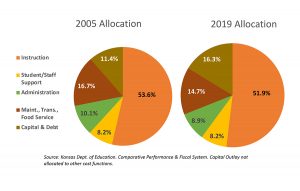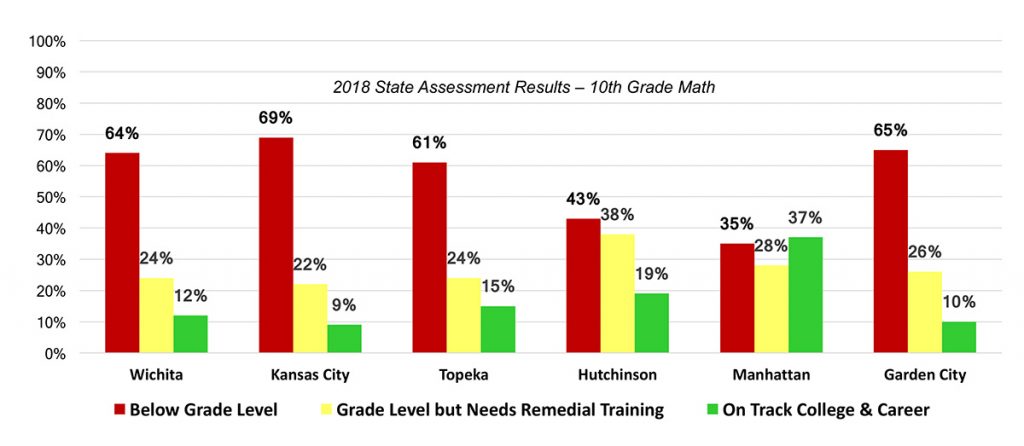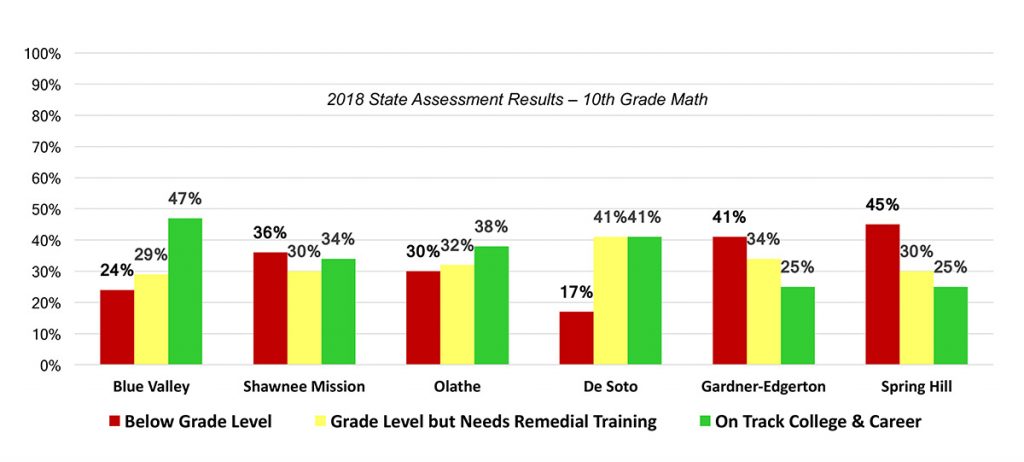The Kansas Education Accounting Manual tells school districts that Instruction – direct interaction between teachers and students – is “…the most important part of the education program, the very foundation on which everything else is built. If this function fails to perform at  the needed level, the whole educational program is doomed to failure regardless of how well the other functions perform.” Knowing this, local school boards and administrators reduced the share of spending allocated to Instruction last year to a new low of just 51.9%. Kansas Policy Institute has been tracking district spending allocation since 2005.
the needed level, the whole educational program is doomed to failure regardless of how well the other functions perform.” Knowing this, local school boards and administrators reduced the share of spending allocated to Instruction last year to a new low of just 51.9%. Kansas Policy Institute has been tracking district spending allocation since 2005.
Spending data for each district is compiled from the Comparative Performance and Fiscal System (CPFS), with Capital Outlay spending all counted as capital. KSDE allows some capital spending to be allocated to other cost function but that can show spikes and large declines for some districts, so we report all capital outlay in one account in the adjacent graphic and for district comparisons found on KansasOpenGov.org.
 After the state supreme court ordered an $853 million spending increase in 2005, the Legislature passed a policy goal telling districts that most of the new money should go to Instruction, with a target of 65% of total spending. Counting capital outlay allocated to Instruction, districts put 54.2% of total spending into Instruction in 2005, and nudged the allocation a little over 55% in a few years. Since then, the allocation including capital outlay has declined and it also hit a new low last year, at 52.8%.
After the state supreme court ordered an $853 million spending increase in 2005, the Legislature passed a policy goal telling districts that most of the new money should go to Instruction, with a target of 65% of total spending. Counting capital outlay allocated to Instruction, districts put 54.2% of total spending into Instruction in 2005, and nudged the allocation a little over 55% in a few years. Since then, the allocation including capital outlay has declined and it also hit a new low last year, at 52.8%.
Had districts followed the Legislature’s policy, $8.6 billion more would have been spent on Instruction since 2006. Even a gradual increase in the allocation would have resulted in billions more being allocated to Instruction. For example, an annual increase of one percentage point until the 65% level was reached would have resulted in $5.7 billion more being spent on Instruction.
81 districts cut Instruction spending last year
While suing taxpayers on the premise funding is inadequate to educate students, 81 districts reduced per-pupil spending on Instruction last year, including three of the four plaintiff districts – Wichita, Hutchinson and Dodge City. USD 500 Kansas City notched a small increase of 0.8%. Districts statewide averaged a 1.7% increase on Instruction while total spending increased 3.4%.
Achievement won’t improve until school boards are held accountable
Money matters, of course, but it’s how money is spent that can improve achievement rather than simply spending more in total. Local school boards and administrators have shown they won’t spend money where it can make a difference, defying both legislative policy and the Department of Education Accounting Manual guidance.
The House of Representatives narrowly passed a bill to require districts to certify that they’ve allocated sufficient funds to Instruction so that students can get to grade level but the Senate didn’t get to vote on the bill. School superintendents and unions will again vehemently oppose that accountability measure when it returns in the 2020 session, but achievement won’t improve until school boards and administrators are held accountable.
State assessment results show the majority of 10th-grade students in many of the state’s largest cities are below grade level in math, with just a small portion being on track for college and career.
USD 259 Wichita has 64% below grade level, 24% at grade level but still in need of remedial training, and just 12% on track for college and career. Kansas City, Topeka, and Garden City have similar results. In USD 308 Hutchinson, 43% are below grade level, 38% need remedial training while considered at grade level, and just 19% are on track. USD 383 Manhattan has about a third of students in each category.
 Even Johnson County, considered by some to have the best schools in Kansas, has serious problems. In USD 229 Blue Valley, 24% of 10th-graders are below grade level in math, 29% are considered at grade level but still need remedial training, and 47% are on track for college and career. Shawnee Mission and Olathe have about a third of students in each category. De Soto has the smallest level of kids below grade level – 17% – and 41% in each of the other categories. In the other two districts – Gardner-Edgerton and Spring Hill – the largest share of students are below grade level.
Even Johnson County, considered by some to have the best schools in Kansas, has serious problems. In USD 229 Blue Valley, 24% of 10th-graders are below grade level in math, 29% are considered at grade level but still need remedial training, and 47% are on track for college and career. Shawnee Mission and Olathe have about a third of students in each category. De Soto has the smallest level of kids below grade level – 17% – and 41% in each of the other categories. In the other two districts – Gardner-Edgerton and Spring Hill – the largest share of students are below grade level.
 Stating these inconvenient truths often evokes anger, but if Kansans really want to do something ‘for the kids,’ they need to encourage legislators to pass real accountability measures.
Stating these inconvenient truths often evokes anger, but if Kansans really want to do something ‘for the kids,’ they need to encourage legislators to pass real accountability measures.




